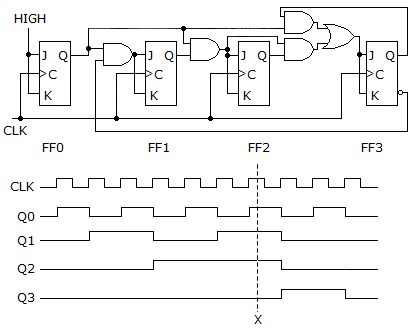Counters problems
- 1. An asynchronous binary up counter, made from a series of leading edge-triggered flip-flops, can be changed to a down counter by ________.
Options- A. taking the output on the other side of the flip-flops (
 instead of Q)
instead of Q) - B. clocking of each succeeding flip-flop from the other side (
 instead of Q)
instead of Q) - C. changing the flip-flops to trailing edge triggering
- D. all of the above Discuss
Correct Answer: all of the above
- 2. A sequential circuit design is used to ________.
Options- A. count up
- B. count down
- C. decode an end count
- D. count in a random order Discuss
Correct Answer: count in a random order
- 3. ________ is the output frequency of the counter shown below.

Options- A. 4 MHz
- B. 20 kHz
- C. 210.5 kHz
- D. 800 Hz Discuss
Correct Answer: 20 kHz
- 4. One method of troubleshooting involves ________ the circuit under test with a ________ or ________ and then observing the output to check for proper bit patterns.
Options- A. checking, voltmeter, ohmmeter
- B. exercising, stimulus, test pattern
- C. testing, scope, logic analyzer
- D. smashing, hammer, axe Discuss
Correct Answer: exercising, stimulus, test pattern
- 5. The given circuit represents a(n) ________.

Options- A. four-bit binary counter
- B. asynchronous BCD decade counter
- C. synchronous BCD decade counter
- D. BCD-to-decimal decoder Discuss
Correct Answer: synchronous BCD decade counter
- 6. Many parallel counters use ________ presetting whereby the counter is preset on the active transition of the same clock signal that is used for counting.
Options- A. feedback
- B. synchronous
- C. ripple
- D. asynchronous Discuss
Correct Answer: synchronous
- 7. The technique used by one-shots to respond to an edge rather than a level is called ________.
Options- A. level management
- B. edge triggering
- C. trigger input
- D. edge trapping Discuss
Correct Answer: level management
- 8. Assume you want to determine the timing diagram for a 4-bit counter using an oscilloscope. The best choice for an oscilloscope trigger signal is ________.
Options- A. the most significant bit (MSB)
- B. the least significant bit (LSB)
- C. the clock signal
- D. from a composite of the MSB and LSB Discuss
Correct Answer: the clock signal
- 9. Asynchronous counters are often called ________ counters.
Options- A. toggle
- B. ripple
- C. binary
- D. flip-flop Discuss
Correct Answer: ripple
- 10. Assume a 4-bit ripple counter has a failure in the second flip-flop such that it "locks up." The third and fourth stages will ________.
Options- A. continue to count with correct outputs
- B. continue to count but have incorrect outputs
- C. stop counting
- D. turn into molten silicon Discuss
Correct Answer: stop counting
More in Digital Electronics:
Programming
Copyright ©CuriousTab. All rights reserved.
